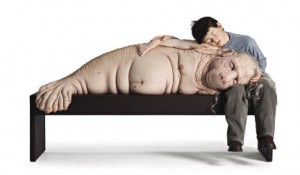Glenbow hosts nightmarish display of childhood
Museum’s dark new exhibit definitely worth price of admission
Ian Ridewood
Contributor
Usually when things go bump in the night, our first instinct is to run away. However, with the Glenbow’s newest exhibition, the first instinct should be to run straight to the museum.
Fairy Tales, Monsters and the Genetic Imagination, organized by the Frist Center for the Visual Arts in Tennessee, is a journey through our history with the denizens living behind the door, under the stairs, and in the shadows of the corners of the room.
Three major sections make up the exhibit, which runs from now until Jan. 3 in the ever-present Calgary icon, the Glenbow Museum.
Within them are many lessons that we have often overlooked in avoiding the spooky subjects.
Viewers are taken through our past with such creatures and are shown how they reflect the morals to which we have been accustomed.
They are confronted with the rationalization of such horrors due to the emergence of science and technology, and are finally exposed to the potential of bioengineering through DNA experimentation, and how we should feel about it.
The Sugar Pill of Fancy and Interspecies Fascination explore the origins of mythology and folklore, and retool preconceived notions of such fairy tales, forcing us to step out of our preconceptions.
The regular tales we know have been turned on their heads: Marcel Dzama’s Room Full of Liars has wooden Pinocchio dolls gazing at the viewer pitilessly, their noses grown long from habitual lying.
In Rapture, Kiki Smith has fashioned Little Red Riding Hood rising out of the husk of the wolf, now a grown woman.
They open the floor to Warning: Monsters, a darker room that drips with horror and surrealism. These works overtly show the causes of such monsters, such as xenophobia, lack of reason, and the fear of death.
Mark Hosford’s Haunting 3 & 4 films orchestrate the room with the drip of blood into a pan and the warped sounds of children’s toys that echo from floor to ceiling.
As you watch the looped clips, your heart beats faster and more audibly. Its palpitations jump at every step, like a child in a darkened room, waiting for a hand to reach out from under the bed.
Pieces such as this serve to show how our fables have come to be — stemming from the characterization of our own, sometimes irrational, fears.
The final section, The Genetic Imagination, concludes the journey with a moral of its own. The art here explores how monsters are found in behavior rather than appearance.
Patricia Piccinini’s hyper-realistic sculptures, which depict imaginary products of DNA experimentation caring for children, explore this theme well.
These displays include a little girl playing with anthropomorphic blobs of matter, an ape-woman suckling a baby, and a boy napping with an aging manatee-human caregiver. They show not only the potential of science, but how we should view such “products”: not as monsters, but as one of us.
This well-organized exhibit holds some deep morals that stretch from the beginnings of language to the potential future. The underlying themes connect the works, and make for an amazing experience.
Although it deals with some explicit themes, such as disturbing and sexual images, families should still make it an event for everyone, as it will evoke discussion among all ages and makes for a memorable experience overall.





